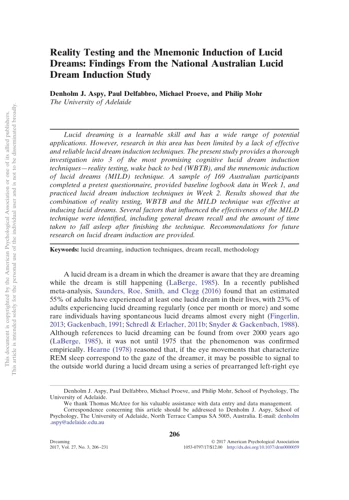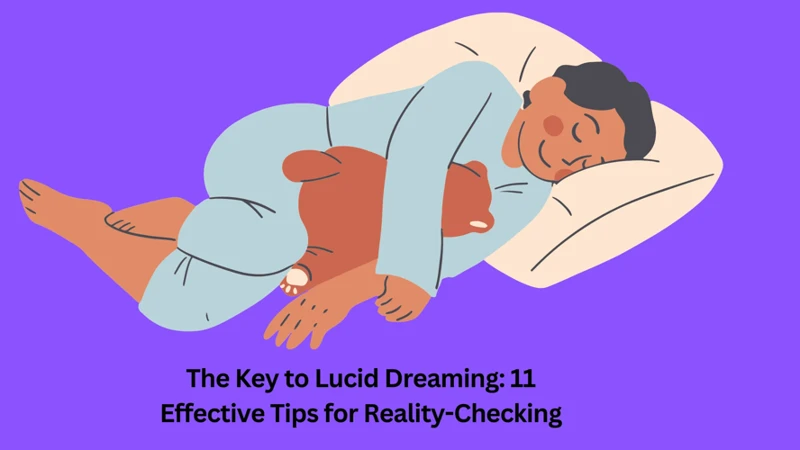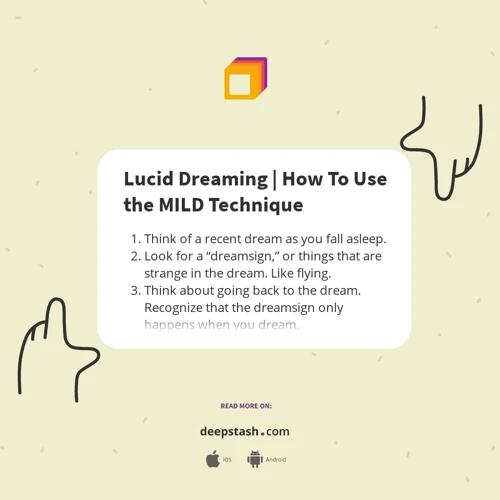Contents
- Introduction
- What Is Reality Testing?
- How to Perform Reality Testing
- Applying Reality Testing in Lucid Dreaming
- Common Mistakes When Using Reality Testing
- Final Thoughts
-
Frequently Asked Questions
- What is the success rate of lucid dreaming with reality testing?
- How long does it take to see results with reality testing?
- Can reality testing be done without prior experience in lucid dreaming?
- Is reality testing safe to use?
- Do I need any special equipment to perform reality testing?
- Can reality testing help overcome nightmares?
- Is lucid dreaming the same as astral projection?
- Is reality testing scientifically proven?
- Can reality testing be used to improve cognitive abilities?
- Is lucid dreaming accessible to everyone?
- References
Introduction

Lucid dreaming is a fascinating phenomenon that has mystified and intrigued humans for centuries. The idea of being able to control and manipulate one’s dreams is both alluring and exciting. While it may seem like something out of a science fiction movie, lucid dreaming is a real and achievable experience. One technique that has proven to be effective in inducing lucid dreaming is reality testing. By incorporating reality testing into your daily routine, you can increase your chances of having a lucid dream and enjoy the benefits that come with it. In this article, we will explore the concept of reality testing and how it can help you achieve lucid dreaming.
What Is Lucid Dreaming?
Lucid dreaming is a phenomenon where one becomes aware that they are dreaming and can consciously control the events and experiences within the dream. It’s basically like becoming the director of your own movie while you sleep. In a lucid dream, the dreamer realizes that they are in a dream state and gains control over the dream’s narrative, characters, and environment.
The following table highlights some key characteristics of lucid dreams:
| Characteristics of Lucid Dreams | Explanation |
|---|---|
| Vividness | Lucid dreams tend to be more vivid and feel more real than regular dreams. |
| Control | The dreamer has some level of conscious control over the dream’s events and experiences. |
| Cognition | The dreamer is aware that they are in a dream state and maintains full waking consciousness while dreaming. |
| Memory | Lucid dreams are often easy to recall and remember due to their vividness and the dreamer’s heightened awareness. |
| Emotions | The emotions experienced in lucid dreams can feel as real as those experienced in waking life. |
Lucid dreaming has been a topic of interest for many researchers and dream enthusiasts for decades. It is a unique experience that offers a range of potential benefits for personal growth, creativity, and psychological well-being. The next section will explore some of the key benefits of lucid dreaming.
The Benefits of Lucid Dreaming
Lucid dreaming has a multitude of benefits for the mind and body. Here are several key advantages:
- Enhanced Creativity: Lucid dreaming allows individuals to explore and manipulate their dreams, which can lead to new and innovative ideas.
- Improved Problem-Solving Skills: As individuals learn to control their dreams, they can practice problem-solving techniques and improve their ability to think on their feet.
- Reduced Anxiety and Stress: Lucid dreaming can be used as a form of therapy to confront fears and reduce anxiety in the waking world.
- Enhanced Self-Awareness: Through lucid dreaming, individuals can gain insight into their thoughts, emotions, and behaviors.
- Improved Motor Skills: Practicing physical movements in a lucid dream can improve muscle memory and enhance motor skills in the waking world.
These are just a few of the compelling reasons to explore the world of lucid dreaming. By learning to control your dreams, you can unlock new levels of creativity and self-awareness, and reduce anxiety and stress in your waking life.
What Is Reality Testing?

One of the most useful tools for inducing lucid dreams is the reality testing technique. If you’ve never heard of it before, you might be wondering: what is reality testing, and why is it so effective at bringing about lucidity during sleep? Essentially, reality testing is the practice of checking whether you are awake or dreaming throughout the day by looking for incongruities in your environment, physical sensations, or cognitive abilities. By doing so, you train your brain to recognize the signs of being in a dream, which can help increase your chances of becoming aware that you are dreaming while you are asleep. Let’s explore this technique in more detail and learn how to incorporate it into your lucid dreaming practice.
The Importance of Reality Testing in Lucid Dreaming
Reality testing is a crucial practice for those who want to achieve lucid dreaming. Lucid dreaming is a state of consciousness where a person is aware that they are dreaming, and they can control their dream narrative. However, achieving lucid dreaming can be difficult, and it requires patience, practice, and the use of various techniques.
The importance of reality testing lies in its ability to increase the self-awareness of a dreamer. Reality testing allows a person to differentiate between reality and a dream state. During a dream, a dreamer may experience various realities, but reality testing can help them determine whether they are awake or dreaming.
By performing reality testing during the day, a person can build a habit of questioning their surroundings and considering whether they are dreaming or not. When a person develops this habit, it is likely to carry over into their dreams, and they will become more aware of their dream state.
In essence, reality testing helps a person establish a habit of questioning their reality. By doing this, the probability of becoming aware of the dream state during a dream increases. This increased awareness is essential for inducing lucid dreaming.
When a dreamer becomes aware of their dream state, they are more likely to take control of their dream narrative. They can manipulate their dreams to their liking, enhance their creativity, and explore their inner self.
Reality testing is an essential practice that should be taken seriously by those who want to master lucid dreaming. By performing reality testing regularly, a person can improve their self-awareness and increase their chances of achieving lucid dreaming.
How to Perform Reality Testing

For those who want to achieve lucid dreaming, reality testing is an indispensable technique that allows dreamers to differentiate between the waking and dreaming states. However, many people may feel perplexed about how to perform reality testing effectively. In this section, we will provide a step-by-step guide on how to perform reality testing and offer tips on how to increase the success rate of lucid dreams through this technique. So, let’s dive into the details!
Reality Test Triggers
Reality testing involves performing certain checks throughout the day to determine whether you are in reality or in a dream state. These checks can be performed during your waking hours as a habit so that they can transfer over to your dream state.
To make the most out of your reality testing, it can be helpful to use “reality test triggers,” which are events or signs that can cue you to perform a reality check. Here are some possible reality test triggers that you can use:
| Trigger | Description |
|---|---|
| Digital Clocks | Check the time on a digital clock or your phone and then look away. Look back at the time and see if it has changed. In a dream, the time on the clock may change randomly or not make sense. |
| Light Switches | Flip a light switch on or off and see if the light turns on or off. In a dream, the light may not respond to the switch. |
| Mirrors | Look at yourself in a mirror and see if your reflection looks normal. In a dream, your reflection may not look like you or may look distorted. |
| Hands | Look at your hands and count your fingers. In a dream, your hands may appear strange or you may have a different number of fingers. |
| Nose | Try to breathe through your nose while pinching it shut. It should be difficult or impossible to breathe in a dream. |
| Gravity | Jump in the air and see if you come back down to the ground normally. In a dream, you may float or fall very slowly. |
These triggers can be personalized to suit your preferences or lifestyle. The purpose of the trigger is to create an automatic response to perform a reality check in your dream state. This way, when you encounter the trigger in your dream, your mind will already be primed to perform the check and help you realize that you are in a dream.
Applying Reality Testing in Lucid Dreaming

Now that we have discussed what reality testing is and its importance in lucid dreaming, it’s time to delve into how to apply it. This technique involves regularly questioning your environment and determining if you are in a dream or reality. By doing so, you become more aware of the subtle differences between dreams and reality, increasing your chances of achieving lucidity while dreaming. In this section, we will discuss the various methods and techniques for incorporating reality testing into your lucid dreaming practice. Additionally, we will explore how to use reality testing to induce and maintain lucid dreams, as well as tips for improving dream recall.
Using Reality Testing to Induce Lucid Dreams
One of the main reasons people use reality testing is to induce lucid dreams. Lucid dreams occur when the dreamer becomes aware that they are in a dream state, which can lead to increased control and clarity within the dream. This is a highly sought after experience, as it allows individuals to explore their subconscious in a unique and exciting way.
To use reality testing to induce lucid dreams, it’s important to establish a consistent routine. This can involve setting triggers during the day and incorporating them into your nightly routine. The triggers can be things like checking the time, counting your fingers, or examining your surroundings.
When working to induce lucid dreams through reality testing, it’s important to remain patient and dedicated. It can take time to become aware of the dream state, and it’s even possible to experience false awakenings or dreams within dreams. To improve your chances of becoming lucid, it’s useful to practice dream recall techniques.
Some effective strategies for improving dream recall include keeping a dream journal by your bed and recording your dreams as soon as you wake up. Another technique is to mentally replay your dreams as you get ready for the day, which can help to reinforce memories of the dream state.
Using reality testing to induce lucid dreams can be a powerful tool for spiritual exploration and self-discovery. With patience and dedication, individuals can increase their chances of experiencing lucid dreams and gain a deeper understanding of their subconscious.
Techniques to Improve Dream Recall
An essential aspect of using reality testing to induce lucid dreams is improving dream recall. Here are some proven techniques to improve the capacity to remember dreams:
- Keep a dream journal: Keeping a dream journal by the bed helps to remember dreams as soon as you wake up. Recording dreams shortly after waking up reinforces them in memory and helps to notice patterns that can be used during reality testing.
- Create a bedtime routine: Establishing a bedtime routine can train the mind to remember dreams regularly. This routine can include calming activities such as listening to soothing music, meditating, or reading a book.
- Select a wake-up time: Waking up at the same time each morning can improve chances of remembering dreams, particularly if it’s a time when sleep cycles are ending.
- Repeat a mantra: Before falling asleep, repeat a phrase such as “I’ll remember my dreams,” which can help set the intention to recall dreams.
- Avoid alcohol and drugs: Alcohol and drugs can reduce REM sleep cycles, which is when most dreaming occurs. Avoiding these substances ensures that there are enough dreaming activities to remember.
Using these techniques consistently over time can improve sleep conditions and recall vivid dreams, enabling a more significant opportunity to achieve lucid dreaming through reality testing.
Common Mistakes When Using Reality Testing
One common mistake that people make when using reality testing to achieve lucid dreaming is inconsistency. If you are not consistent in your reality testing approach, you will not be able to establish a habit of questioning your reality. This makes it more difficult for reality testing to trigger during a dream, making it less effective for inducing lucid dreams.
Another mistake that people make is not believing enough in the reality testing approach. Lucid dreaming is a mental practice, and like most practices, it takes time and patience to master. If you don’t have enough faith in the reality testing technique or don’t believe that it can work for you, you are less likely to achieve lucid dreaming.
Another mistake is relying too much on just one reality testing trigger. While reality testing triggers can be effective, they can also become less effective over time if you rely on them too heavily. It is important to use a variety of triggers to keep your mind stimulated and engaged, increasing the chances of experiencing lucid dreams.
Additionally, some people make the mistake of relying solely on reality testing for achieving lucid dreams. While reality testing is a powerful tool, it is not the only technique available. Combining reality testing with other lucid dreaming techniques, such as keeping a dream journal, practicing meditation, or using lucid dreaming supplements, can be much more effective in achieving lucid dreams.
One final mistake is giving up too easily. Achieving lucid dreams takes time and effort, and it can be frustrating when you don’t see immediate results. However, with continued practice and patience, most people can achieve lucid dreaming. Don’t get discouraged if you don’t experience immediate success, instead, continue to practice and refine your technique until you achieve lucid dreaming.
Final Thoughts
After exploring the concept of lucid dreaming and the importance of reality testing in achieving this state, it is important to acknowledge that learning to lucid dream can be a challenging and time-consuming process. It requires patience and dedication, but the rewards of achieving lucid dreams are immeasurable.
One of the most important things to keep in mind when learning to lucid dream is to not get discouraged if it does not happen right away. Just like any other skill, it takes time to develop and perfect. By setting small goals and practicing reality testing consistently, progress can be made.
Additionally, it is important to remember that lucid dreaming is a personal experience, and there is no “right” or “wrong” way to approach it. Some techniques may work better for certain individuals than others, and it is important to be open to exploring different methods and finding what works best for oneself.
Finally, it is important to approach lucid dreaming with a sense of curiosity and wonder. Learning to explore one’s own subconscious mind can be a powerful and transformative experience, and the possibilities of what can be discovered in a lucid dream are endless.
So if you are interested in learning to lucid dream, remember to be patient, stay curious, and keep exploring the fascinating world of the subconscious mind. With practice and perseverance, the rewards of achieving lucid dreams are well worth the effort.
Frequently Asked Questions
What is the success rate of lucid dreaming with reality testing?
The success rate varies depending on the individual’s practice and consistency, but it can range from 50-80% success in achieving lucid dreams with reality testing.
How long does it take to see results with reality testing?
Results can vary, but with consistent practice, some individuals have reported experiencing their first lucid dream within a week or two of beginning reality testing.
Can reality testing be done without prior experience in lucid dreaming?
Yes, reality testing can be done by anyone regardless of prior experience in lucid dreaming. It is a technique designed to help individuals become more aware of their dream state.
Is reality testing safe to use?
Yes, reality testing is a safe and natural technique that requires no physical or medical intervention.
Do I need any special equipment to perform reality testing?
No, you do not need any special equipment to perform reality testing. It can be done simply through mental exercises and observation of surroundings.
Can reality testing help overcome nightmares?
Yes, reality testing can help overcome nightmares by increasing the individual’s awareness of their dream state and giving them the ability to take control of their dream environment.
Is lucid dreaming the same as astral projection?
No, lucid dreaming and astral projection are two different phenomena. Lucid dreaming is the act of becoming aware of being in a dream, while astral projection is the belief that one’s consciousness can leave their physical body and travel to other dimensions or realms.
Is reality testing scientifically proven?
While there is limited scientific research on reality testing, it is generally recognized as a safe and effective technique for inducing lucid dreaming.
Can reality testing be used to improve cognitive abilities?
While reality testing is primarily used to induce lucid dreaming, the increased awareness and observation skills that come with the practice can potentially improve cognitive abilities in waking life.
Is lucid dreaming accessible to everyone?
Lucid dreaming is accessible to most individuals, but may take different amounts of time and effort depending on the person’s natural abilities and dedication to the practice.







